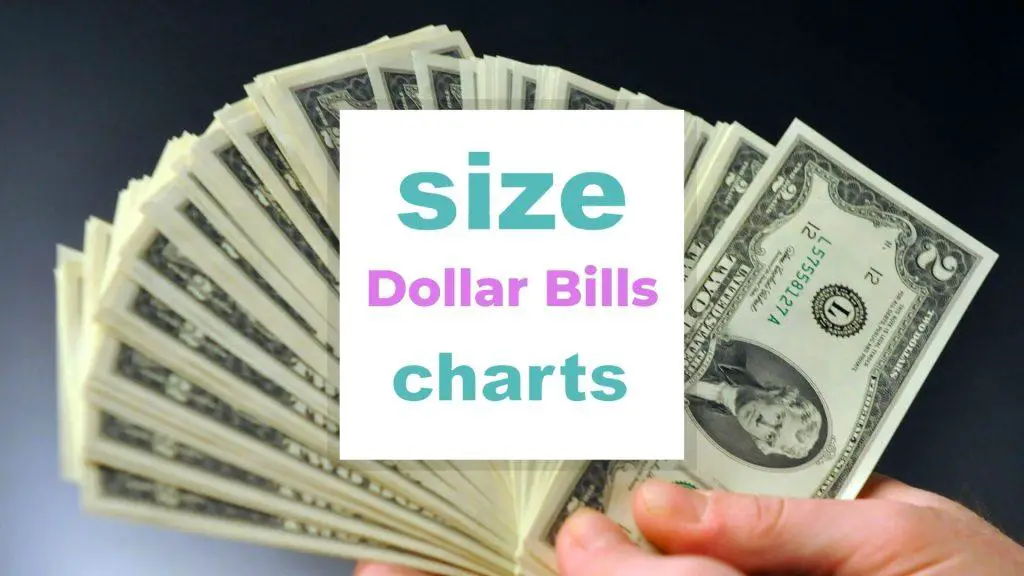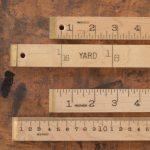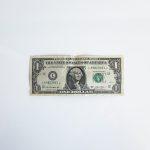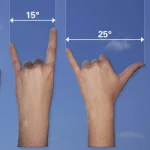Dollar Bills Size Chart
Since 1876, when the United States stopped issuing fractional currency notes, the one-dollar bill ($1), sometimes known as a single, has been the lowest-value denomination of United States paper money. All USA bills, regardless of their denomination, share the same dimensions. They measure 2.61 inches in width and 6.14 inches in length. The thickness of each bill is 0.0043 inches. When it comes to the composition of the paper used, it consists of 25 percent linen and 75 percent cotton. This combination of materials ensures USA currency bills’ durability and distinct tactile feel.

| Value | Width (inches) | Length (inches) | Thickness (inches) | Width (cm) | Length (cm) | Thickness (cm) | Weight (grams) | Weight (oz) |
|---|---|---|---|---|---|---|---|---|
| $1 | 2.61 | 6.14 | 0.0043 | 6.63 | 15.6 | 0.011 | Appr. 1 gr | 0.035 |
| $5 | 2.61 | 6.14 | 0.0043 | 6.63 | 15.6 | 0.011 | Appr. 1 gr | 0.035 |
| $10 | 2.61 | 6.14 | 0.0043 | 6.63 | 15.6 | 0.011 | Appr. 1 gr | 0.035 |
| $20 | 2.61 | 6.14 | 0.0043 | 6.63 | 15.6 | 0.011 | Appr. 1 gr | 0.035 |
| $50 | 2.61 | 6.14 | 0.0043 | 6.63 | 15.6 | 0.011 | Appr. 1 gr | 0.035 |
| $100 | 2.61 | 6.14 | 0.0043 | 6.63 | 15.6 | 0.011 | Appr. 1 gr | 0.035 |
Currently, the obverse features a portrait of George Washington, the first president of the United States (1789–1797), based on Gilbert Stuart’s Athenaeum Portrait from 1796, while the reverse features the Great Seal of the United States (skip straight to the Dollar bills size chart).
The present U.S. dollar bill’s design is the oldest among all denominations (The current two-dollar bill obverse design dates from 1928, while the reverse appeared in 1976). First produced as a Federal Reserve Note in 1963 (with a different design on the reverse), the current design of the dollar bill’s obverse has been in use since that year (previously, one-dollar bills were Silver Certificates).
The $1 bill has 25% linen and 75% cotton. This combination makes the bills harder to forge than paper and also increases their longevity in circulation. The average lifespan of a $1 bill in circulation is 6.6 years as of December 2018. In 2009, one-dollar bills accounted for over 42% of all U.S. money printed. On the 31st of December of this year, there were 12.7 billion one-dollar bills floating across the globe.
Jump right into the Frequently Asked Questions
Related: Jar Size Guide: How to Choose the Right Size?, Wine Bottle Sizes & Different Types by Name & amount of glasses Blackstone Griddle size and barbecue dimensions
Dollar Bills Size Table of Contents
Dollar bills size chart
Related: Hydro flask size chart by type, volume and usage, Bar Sink Dimensions and Measuring Guide for Kitchen Sink sizes
One Dollar Bill
| Value | $1 |
| Width | 6.14 inches ≈ 156.1 mm |
| Height | 2.61 inches ≈ 66.3 mm |
| Weight | Approx. 1 |
| Security Features | Security fibers, raised printing |
| Materials Used | 75% cotton 25% linen |
| Year of printing | 1929 – present (Small size) |
Two Dollar Bill
| (United States) | |
|---|---|
| value | $2.00 |
| width | 6+9⁄64 inches ≅ 156 mm |
| height | 2+39⁄64 inches ≅ 66.3 mm |
| weight | Approx. 1 g |
| security features | Security fibers, raised printing |
| material used | 75% cotton 25% linen |
Ten Dollar Bill
| (United States) | |
|---|---|
| Value | $10 |
| width | 156 mm – 6.14 in |
| height | 66.3 mm – 2.6 in |
| weight | Approx. 1 g – 0.0022 lbs |
| security features | Security fibers, watermark, 3D security ribbon, security thread, color-shifting ink, microprinting, raised printing, EURion constellation |
| Material used | cotton linen |
Twenty Dollar Bill
| (United States) | |
|---|---|
| Value | $20 |
| width | 156 mm -6.14 in |
| height | 66.3 mm – 2.6 in |
| wieght | c. 1.0 g – 0.0022 lbs |
| security features | fibers, watermark, 3D security ribbon, security thread, color-shifting ink, microprinting, raised printing, EURion constellation |
| material used | 75% cotton 25% linen |
Fifty Dollar Bill
| (United States of America) | |
|---|---|
| value | $50 |
| width | 156 mm – 6.14 in |
| height | 66.3 mm – 2.6 in |
| weight | Approx. 1.0 g – 0.0022 lbs |
| security features | security fibers, watermark, security thread, color-shifting ink, microprinting, raised printing, EURion constellation |
| material used | 75% cotton 25% linen |
One Hundred Dollar Bill
| (United States) | |
|---|---|
| Value | $100 |
| width | 156 mm – 6.14 in |
| Height | 66.3 mm – 2.6 in |
| Weight | ≈ 1.0 g – 0.0022 lbs |
| Security features | fibers, watermark, 3D security ribbon, security thread, color-shifting ink, microprinting, raised printing, EURion constellation |
| Material used | 75% Cotton 25% linen |
| 1861–present |
How to choose the right dollar bill sizes
Related: Pizza Sizes: Which One to Order?
It is important to note that you can buy things with one dollar, two dollars, five dollars, ten dollars, fifty dollars, or a hundred dollars worth of American paper currency. Larger denomination bills, such as $500, $1,000, $5,000, and $10,000 bills, are no longer printed in the United States.
The thickness of a dollar bill is.0043 inches and it weighs 1 gram. To determine its dimensions, get a ruler and learn that it is 2.61 inches in width and 6.14 inches.
The United States produces 31% of its cash as one-dollar bills.
As of 2018, there were around 12.7 billion one-dollar bills, 1.3 billion two-dollar bills, 3.2 billion five-dollar bills, 2.1 billion ten-dollar bills, 9.5 billion twenty-dollar bills, and 14.2 billion one-hundred-dollar bills in circulation.
They put ninety percent of shredded Federal Reserve Notes to use again. They put some of them into gift bags for people who have visited Federal Reserve Banks. They make products like cellulose insulation for homes and fuel for power plants from this material. Some of it is composted and used as plant food for things like trees.
Seventy-five percent of each one-dollar bill is made out of cotton and linen, making them more durable and able to maintain a smooth surface for longer than regular paper. The new material used to make dollar bills will ensure their durability for decades to come. Thus, the United States dollar coins have undergone the most dramatic changes of any currency in the world.
In the last two hundred years, there have been at least a dozen different types of dollar coins in use. You’ll find that each dollar coin is unique in terms of the metals used, the design elements included, and the weight it carries. In this thread, we’ll discuss everything that goes into the value of a dollar.
The thickness of a dollar bill
To put it plainly, money is exchanged for goods and services. It’s best defined as something promised or promised to be received in exchange for goods or services exchanged. Silver and gold coins were first minted to protect the value of the currency. To avoid any confusion over their worth, they were all given uniform weights and stamped with distinctive designs.
In the 1600s, England became a pioneer in the usage of paper currency. When people deposited coins with goldsmiths, they received paper receipts with the same value as the coins. Companies accepted these receipts because with them they could get their money back from the goldsmiths.
Skilled engravers carve into steel plates the designs on today’s paper currency. The portraits are the domain of one engineer, while the text is the domain of another. Other engineers take care of all the other designs. Next, they transferred the engraving to a transfer press, where it is crushed against a steel roller, permanently imprinting the design into the roller’s surface.
After the design is transferred to a printing plate, the banknotes are ready to be printed. They printed government currency on special paper with security ink to prevent counterfeiting. They kept the ink and paper used by the Bureau of Engraving and Printing under tight security.
American currency notes are a specific size, thickness, and design. A standard U.S. one-dollar bill has dimensions of 6.6294 by 15.5956 by 0.010922 centimeters. Besides a serial number and treasury seal, currency features the year the bill was designed, the Federal Reserve District it was issued in, the number of that district’s Federal Reserve Bank, and the number of the district’s Federal Reserve Bank.
How much does a dollar bill weigh?
To the nearest gram, a US dollar bill weighs exactly 0.98 grams or 0.03456848 ounces. According to the US Bureau of Engraving and Printing, the value of one metric ton of a one-dollar bill is $980,000.
One-dollar bills may not be worth much now that there are over 11 billion still in circulation, but if you added up all the notes now in circulation, you’d have billions. These one-dollar bills also appear to be quite mobile, as they are rarely seen in the same place twice. As many can handle A single dollar bill as fifty persons in a single year, if it has been in circulation for decades, they have certainly used it thousands of times.
The look, feel, and weight of the one-dollar bill have evolved. The current design of our dollar bill has altered little in almost 50 years, and the last time they printed it was in 1963. Since then, they have made only minor adjustments to the overall layout. The original U.S. President George Washington is shown on the front of the one-dollar bill. The pyramid and the American eagle can be seen on the reverse of this note. The ubiquitous green one-dollar bill weighs just a scant 0.03 ounces and is accepted everywhere in the United States (1 gram).
According to the United States Government Printing Office, a one-dollar bill weighs one gram. Notes of all denominations issued by the United States Treasury weigh the same. One pound is 454 grams or 454 dollars. The Bureau claims these bills are 75 percent cotton and 25 percent linen, making them durable enough to withstand 4,000 folds before separating.
They printed banknotes with green ink, which is resistant to chemicals, to represent the strength and dependability of the currency. The Federal Reserve Bank of New York created a $100,000 banknote in the 1930s that could only be used for Federal Reserve business.
Learn more about dollar bills size and more (video)
Frequently asked questions
1. How big is the one-dollar bill?
Size: 6.14 x 2.61
All Federal Reserve notes are made around 30 percent smaller, measuring in at 6.14 x 2.61 inches instead of 7.375 x 3.125 inches, to save manufacturing costs.
2. What are the largest dollar bills?
U.S. Federal Reserve Bank notes are currently available in denominations of $1, $2, $5, $10, $20, $50, and $100. In its history, the Federal Reserve has only ever issued $10,000 notes to the public.
3. Are all dollar bills the same?
No matter their value, all banknotes i.e. dollar bills are the same size. A 2.61-inch width and a 6.14-inch length are the measurements. It is 0.043 inches thick. To make the paper, we used 25% linen and 75% cotton.
4. How much weigh ten dollar bills?
It’s estimated that a single US ten-dollar bill weighs about 1 gram, or precisely 0.98 Grams, or 0.03456848 ounces. According to the US Bureau of Engraving and Printing, the value of one metric ton of 10-dollar bills is $9.80 million.
5. How many dollar bills equal one pound?
Cotton and American Dollars. The US Bureau of Engraving and Printing states that its paper currency contains 75% cotton and 25% linen. Each pound of currency has the equivalent of three-quarters of a pound of cotton. According to the same authority, there are 454 single bills in a pound of money.
6. How much weigh 100-dollar bills?
| Value | $100 dollar bill |
|---|---|
| Width | 156 mm |
| Height | 66.3 mm |
| Weight | ≈ 1.0 g |
| Security features | fibers, watermark, 3D security ribbon, security thread, color-shifting ink, microprinting, raised printing, EURion constellation |
| Material used | 75% Cotton 25% linen |
| Years of printing | 1861–present |
7. Is a dollar bill 16 centimeters?
The length of a dollar note is around 16 centimeters, therefore if I hold my fingers over the middle of the bill, the top edge has about 8 centimeters of the fall distance.
Conclusion
According to the Federal Reserve Board of the United States, each one gram of cash is legal tender. The value of a dollar bill has changed a lot since it was first printed, yet its weight has stayed about the same for decades. The iconic green $1 bill has been in circulation since its inception in 1963, with few changes to the design.
All legal dollar notes and coins are worth the same amount of money, although they may look very different and have very different weights and sizes depending on when they were formed and what they were made of. To further understand this, let’s dissect some of the most recognizable American dollars.
Gold and silver IRAs are great for people who enjoy collecting paper currency and physical coins. Precious metals are a safe investment that can help you safeguard your retirement savings. Gold IRA holders have the option of storing bullion or coins in their retirement accounts.
Thank you for reading our article. For any inquiries leave the comment section and we will gladly respond to your questions.
Picture in this post is by Kenny Eliason on Unsplash
Related to Dollar Bills Size
- Barbie Doll Size : What are different sizes of Barbie ?
- Blanket sizes chart : blanket sizes and dimensions in inches & cm
- Tablecloth size chart – What are standard tablecloth sizes ?
- How Many Meters Are In A Yard?
- How Many Centimeters are 8 Inches?
- Knife Sizes and Different Types
- 4 Inches is How Many Centimeters?
- Light Bulb Base Sizes : What size light bulb base do I need?
- Tesalate Towel Size Guide
- Light bulb Size : What are the different and standard bulb sizes?
- Duvet Sizes: What is a Standard-Size Duvet?
- Single Car Garage Size and Dimensions
- How High Is A Story?
- How Much Does 1 Cup Of Rice Weigh?
- Cast Iron Skillet Sizes: What Size Do I Need?
- Dollar Bills Size Chart
- Pizza Sizes: Which One to Order?
- How To Measure A Foot Without A Ruler
- Wine Glass Size Chart
- Tiny Houses Size Charts
- How Many Inches Are In 20 Centimeters?
- How To Measure 1 Meter Without A Ruler?
- Nightstand Size and Dimensions for Bedroom
- Lamp Shade Size Guide – What size lampshade do I need?
























